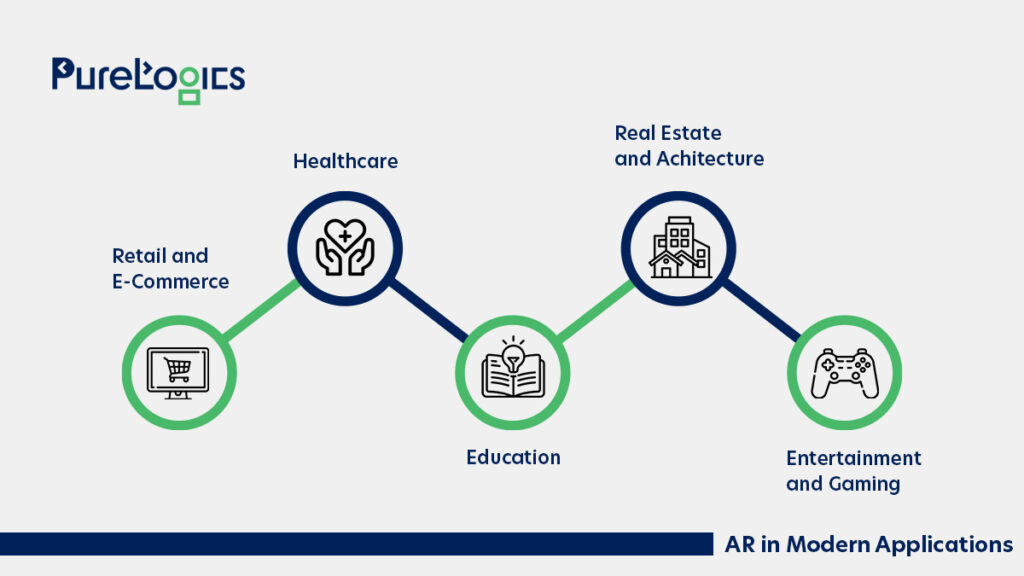Augmented Reality (AR) has transcended from a futuristic concept to a vital part of modern technology, influencing various industries, from gaming to healthcare. AR, which overlays digital information onto the real world through devices like smartphones, tablets, or AR glasses, offers an interactive experience that blends the physical and digital realms. As AR technology evolves, its potential in modern applications continues to expand, driving innovation and reshaping how we interact with the world.
This blog post explores the vast potential of AR in contemporary applications, highlighting its transformative effects on various sectors.
Understanding Augmented Reality
Augmented Reality is a technology that superimposes digital elements, such as images, sounds, or other data, onto the real world. Unlike Virtual Reality (VR), which immerses users in a completely virtual environment, AR enhances the real world by adding layers of digital information. This is achieved through devices like smartphones, tablets, AR glasses, or headsets equipped with cameras and sensors that map the physical environment and project digital content into it.
The core of AR lies in its ability to blend the physical and digital worlds seamlessly, offering an interactive and immersive experience. This blending of realities opens up a plethora of opportunities across various domains, allowing users to interact with digital content in ways that were previously unimaginable.
Transform Engagement through Augmented Reality
Bridge digital and physical worlds to captivate audiences and revolutionize user experiences.
Evolution of AR Technology
The journey of AR technology began in the 1960s with the development of the first head-mounted display systems. However, it wasn’t until the 1990s and early 2000s that AR started gaining traction, thanks to advancements in computing power and the proliferation of smartphones.
The launch of ARToolKit in 1999, an open-source library for AR applications, marked a significant milestone in the development of AR technology.
The real breakthrough came in 2016 with the launch of Pokémon GO, a mobile game that utilized AR to allow players to capture virtual creatures in the real world. This game not only showcased the potential of AR in entertainment but also demonstrated its mass-market appeal. Since then, AR technology has continued to evolve, with significant improvements in hardware, software, and user interfaces, making it more accessible and versatile than ever before.
AR in Modern Applications

Retail and E-Commerce
One of the most prominent applications of AR is in retail and e-commerce. AR allows customers to visualize products in their environment before making a purchase, bridging the gap between online and in-store shopping experiences.
For instance, furniture retailers like IKEA have introduced AR apps that enable users to see how a piece of furniture would look and fit in their home before buying it. Similarly, fashion brands are leveraging AR to offer virtual try-ons, allowing customers to see how clothes, accessories, or makeup will look on them without physically trying them on.
This application of AR not only enhances the shopping experience but also reduces the likelihood of returns, as customers can make more informed purchasing decisions. As AR technology becomes more sophisticated, we can expect to see even more personalized and immersive shopping experiences.
Healthcare
AR is revolutionizing the healthcare industry by providing new ways to visualize and interact with medical data. Surgeons, for example, can use AR to overlay critical information, such as patient scans or real-time data, onto their field of view during surgery. This allows for more precise and informed decision-making, potentially improving surgical outcomes.
Additionally, AR is being used in medical training, where students can interact with 3D models of the human body, enhancing their understanding of complex anatomical structures. Patients can also benefit from AR through applications that help explain medical procedures or conditions, making healthcare more accessible and understandable.
Education
AR is transforming education by providing interactive and immersive learning experiences. Traditional textbooks are being enhanced with AR content, allowing students to interact with 3D models, animations, and videos that bring subjects to life.
For example, AR apps can turn a simple biology textbook into an interactive experience where students can explore the human body in 3D, rotate organs, and see how different systems function.
In addition to enhancing traditional learning, AR is also being used in vocational training. For instance, AR can simulate complex machinery or environments, allowing trainees to practice tasks in a safe and controlled setting before applying their skills in the real world.
Real Estate and Architecture
AR is making waves in the real estate and architecture industries by offering immersive experiences that allow potential buyers or tenants to visualize properties without physically visiting them. Real estate agents can use AR to create virtual tours of properties, providing a detailed view of the space and its features. This not only saves time but also helps in making more informed decisions.
Architects and designers are also using AR to overlay their designs onto the real world, allowing clients to see how a building or interior design will look once completed. This ability to visualize and interact with designs before they are built is transforming the way architects and clients collaborate, leading to more efficient and creative design processes.
Entertainment and Gaming
The entertainment and gaming industries have been at the forefront of AR adoption, using it to create immersive experiences that blur the lines between the virtual and real worlds. Pokémon GO is the most well-known example, but the potential of AR in gaming goes far beyond this. AR can turn any environment into a game space, with digital characters and objects interacting with the real world.
In addition to gaming, AR is being used in live events, such as concerts and sports, to enhance the audience’s experience.
For example, AR can be used to project digital effects onto the stage or field, creating a more dynamic and engaging experience for viewers. The integration of AR into entertainment is only beginning, and as technology advances, we can expect to see even more innovative and immersive experiences.
Challenges and Future Prospects
While the potential of AR is immense, there are still challenges to overcome. One of the primary challenges is the hardware limitations, such as the bulkiness of AR glasses and the limited battery life of AR devices. Additionally, creating high-quality AR content requires significant resources, including advanced software and skilled developers.
Privacy and security concerns also pose a challenge, as AR applications often require access to camera data and other sensitive information. Ensuring that AR technology is used responsibly and ethically is crucial for its widespread adoption.
Despite these challenges, the future of AR looks promising. As hardware continues to improve and costs decrease, AR technology will become more accessible to both developers and consumers. The integration of AR with other emerging technologies, such as Artificial Intelligence (AI) and the Internet of Things (IoT), will further enhance its capabilities, opening up new possibilities for innovation.
Final Remarks
Augmented Reality is no longer a technology of the future; it is a powerful tool that is already transforming various industries. From retail and healthcare to education and entertainment, AR is enhancing our interactions with the world and creating new opportunities for innovation. As AR technology continues to evolve, its potential in modern applications will only grow, offering exciting possibilities for the future.
Whether it’s improving the shopping experience, revolutionizing medical procedures, or creating immersive educational tools, AR is poised to play a significant role in shaping the future of technology.
For more information, feel free to contact PureLogics.


 [tta_listen_btn]
[tta_listen_btn]
 October 28 2024
October 28 2024






